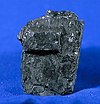Coalification
The coalification is the natural process of the formation of coal .
Over a period of millions of years, coalification leads from fresh plant material to humic acids and peat , then via lignite and hard coal to anthracite , and in some cases even to graphite . The proportion of water and volatile components is constantly decreasing, so that the relative proportion of carbon increases, which is almost 100% in graphite. So far it has not been possible to fully understand this process.
Phases of coalification
The coaling takes place in two phases. Immediately after the plant dies, the biochemical phase begins , the peat formation, in which fungi and bacteria convert cellulose and lignin into humic substances . Due to the increasing influence of geothermal energy, the geochemical phase of coalification begins , which is mainly influenced by the temperature and pressure conditions. While the biochemical conditions are in the foreground for the process of coalification up to lignite (especially oxygen depletion due to the exclusion of air), geochemical factors gain in importance with the conversion into hard coal, anthracite and graphite.
Biochemical coalification phase
After the parts of the plant die, they begin to break down. Microorganisms first break down carbohydrates and proteins , and finally cellulose and lignin , too, and peat forms. The peat is compressed and drained by the continuous deposition of new parts of the plant. The peat layer becomes thicker and thicker as the educational areas sink. With increasing depth, the further coalification continues abiotic. With further subsidence, the bogs are covered by sea and river sediments. If the subsidence is then reduced, another layer of peat can form. These processes can be repeated several times, so that several layers of peat are created.
Due to the complex and partly unknown chemical structure of the lignins and humic substances involved in these processes, an exact chemical representation of the processes is not known. During this first phase, the carbon content of the dry matter increases rapidly from approx. 40% to over 60%.
Geochemical coalification phase
In the second phase, the water content continues to decrease: from 75% at the peat / lignite transition to 10% at the lignite / hard coal border. The carbon content continues to increase due to the release of water, carbon dioxide and methane . While cellulose and lignin are still to be found in young lignite, as the process progresses, the cellulose first disappears and, at the transition to hard coal, the lignin also disappears. In the coal stage, the splitting off of methane is decisive, but hydroxyl , carboxy , methoxy and carbonyl groups are also increasingly being split off. In this way, the rock-forming elements of coal, the macerals, are formed .
Visible petrographic changes
The process of coalification leads to visible petrographic changes in the coal rocks:
| Coal rock | description | image |
|---|---|---|
| peat | loose, crumbly, lots of stored plant remains |

|
| Soft brown coal | denser and stronger than peat, often regulated parts of plants that cause stratification, light to dark brown color. | |
| Matt brown coal | firm, dark brown to black color. |

|
| Luster brown coal | Firm structure with shell-like break and pitch luster at break edges, black color, but brown line . |

|
| Hard coals | solid structure, alternation of matt and glossy layers, black color and black line. |

|
Coalification through technical processes
The process of coalification can be imitated by heating biomass in pressure vessels ( hydrothermal carbonization ) and takes place there within hours.
literature
- KH Schmidt, I. Romey, F. Mensch: Coal, petroleum, natural gas: chemistry and technology . Vogel Verlag, 1981, ISBN 3-8023-0684-8 , ISBN 978-3-8023-0684-6
- Ullmanns Enzyklopadie der Technischen Chemie, 4th edition, Volume 14, pages 288-292, 1977, Verlag Chemie, Weinheim